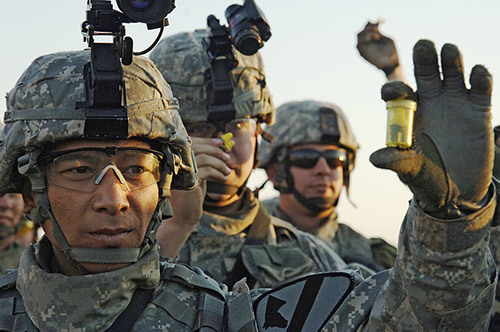Updated
3M earplug lawsuits are mass tort claims against 3M and Aearo Technologies, the companies that designed and manufactured combat earplugs for the U.S. military from 2003 through 2015. The defective design of those earplugs kept them from fitting snugly in the wearer’s ear. As a result, numerous soldiers have suffered permanent hearing loss and tinnitus. There is also evidence that 3M discovered evidence of the defect, but covered it up.
In this article, our products liability lawyers explain how 3M’s earplugs were a defective product, and the hearing damage that the earplugs caused to the U.S. service members who relied on them. We will then look at the lawsuits that have been filed against 3M over those defects, including allegations that 3M covered up evidence of the dangers posed by their earplugs. Finally, we will discuss the compensation you may be entitled to receive and what you can do if you have suffered from the defects of 3M’s earplugs.
- 1. 3M’s Combat Arms Earplugs
- 2. How the earplugs were defective
- 3. Damages caused by CAEv2 earplugs
- 4. Lawsuits over Combat Arms Earplugs
- 5. Compensation for hearing loss or tinnitus
- 6. What you can do if you have suffered tinnitus or hearing loss
- 7. Contact our products liability lawyers

The CAEv2 was standard issue in the U.S. Government Armed Forces from 2003 through 2015.
1. 3M’s Combat Arms Earplugs, or CAEv2
The defective earplugs are 3M’s Combat Arms Earplugs Version 2, commonly referred to as CAEv2. The CAEv2 was standard issue for U.S. military personnel from 2003 through 2015. These hearing protection devices were designed and manufactured by a defense government contractor, Aearo Technologies, which was subsequently purchased by the multinational conglomerate 3M Company (headquartered in St. Paul, Minnesota).
Combat Arms Earplugs are “dual-sided” – each side of the earplug can be inserted into the user’s ear for a different effect. When the dark green end of the earplug is inserted into the ear, it is supposed to reduce all noises and offer hearing protection, just like a traditional earplug. However, when the yellow side is inserted into the ear, it is only supposed to reduce the disorienting effects of loud combat noises. Low-level noises like speech and even footsteps are supposed to travel through the yellow side of the earplug, unblocked.
To do this, the CAEv2 uses a sound channel and filter in the yellow side of the earplug. The louder the sound, the more the filter blocks it.
2. How the earplugs were defective
3M’s Combat Arms Earplugs were defective because the way they were designed made it difficult to insert into the ear hole.
When a soldier would insert one side of a CAEv2 into their ear hole, it would compress the edge of the opposite side against the outer rim of their ear hole. When the soldier released the earplug, the edge of the compressed and exposed side of the CAEv2 would decompress. The decompression would push the earplug out of the soldier’s ear far enough to drastically reduce the efficacy of the earplug. However, the shift in movement was not enough to be perceptible to the soldier.
As a result, many service members in the Armed Forces were exposed to extremely loud noises, relying on the false promise that they were being protected from hearing loss and other ear damage.
3. Damages caused by CAEv2 earplugs
The defects in 3M’s Combat Arms Earplugs have been linked to several serious hearing and auditory injuries in service members, including:
- Hearing loss,
- Tinnitus, and
- Loss of balance.
These are not trivial conditions. The two most prevalent disabilities suffered by military veterans in the U.S. are hearing loss and tinnitus, with tinnitus affecting 9.7% of veterans, and hearing loss affecting 5.8%.1
Worse, these medical conditions are completely preventable.

A whistleblower filed a qui tam lawsuit on behalf of the government against 3M in 2016.
4. Lawsuits over Combat Arms Earplugs
Little was known about the defects in the CAEv2 earplug until a whistleblower filed a qui tam lawsuit on behalf of the federal government against 3M in 2016.2 Since that case, numerous product liability claims have been filed against 3M for hearing loss and other injuries sustained because of the defective design in the CAEv2.
4.1 The whistleblower lawsuit over 3M’s earplugs
In the whistleblower lawsuit, the plaintiff claimed that Aearo Technologies and its subsequent purchaser, 3M, knew of the defect in their earplugs as early as 2000. However, they covered it up in a sham testing procedure and then used the results of that testing process to secure lucrative contracts with the U.S. Department of Defense.
According to the qui tam lawsuit, Aearo had to test their earplugs and achieve a noise reduction rating (NRR) requirement for the military.3 Rather than hire an independent facility to conduct the testing, though, Aearo did it in-house, using its own employees.4
This testing found that the yellow side of the CAEv2 was scoring a -2 NRR – meaning it was actually magnifying sound.5 Allegedly because Aearo knew this would be a suspicious result, it “rounded up” the NRR score to 0 – a score that meant the defective combat earplug had no impact on noise levels.6 Aearo then touted this score as proof that the CAEv2 would allow military members to interact with their surroundings like normal while using the yellow side of the earplug.7
Meanwhile, tests on the dark green side, which was supposed to completely block sound, led to average NRR numbers well below what was expected. This end was expected to receive an NRR of 22, but after testing 8 subjects, it was only averaging an NRR of 10.9.8 The low number was largely because so many of the earplugs were sliding out of the test subject’s ears due to the design defect.9
Aearo investigated the problem and discovered that, if the edge of the yellow side of the CAEv2 was folded back on itself before the dark green side was inserted, it would not dislodge the earplug.10 Subsequent testing led to an average NRR score of 22.11 However, the yellow side of the CAEv2 was not retested using this new insertion method.12
When the CAEv2 was sold to the United States military, though, the instructions said to simply insert the earplugs, making no mention of folding back the edge of the exposed side of the earplug.13
The qui tam lawsuit claimed that these misleading statements to the government amounted to a violation of the False Claims Act.14
In 2018, 3M agreed to settle the case with the Justice Department for $9.1 million without admitting liability.15
4.2 Subsequent products liability claims by injured veterans against 3M
In the aftermath of the qui tam lawsuit’s settlement, numerous veterans who had developed hearing loss and tinnitus have filed products liability lawsuits against 3M.
These 3M lawsuits claim that the design defects in 3M’s Combat Arms Earplugs caused serious injuries. Additionally, the lawsuits also claim that 3M’s failure to warn soldiers of CAEv2‘s problems, as well as how to prevent them through proper insertion, contributed to hearing loss and tinnitus. Many lawsuits also claim breaches of warranty and fraud.
Because so many people have likely been hurt in the same or similar ways, the military lawsuits were ripe for consolidation into a multidistrict litigation, or MDL. This allows one federal district court to handle all of the lawsuits for pretrial procedures, including:
- Evidence gathering and discovery,
- Motions to dismiss,
- Summary judgment motions, and
- Evidentiary motions.
The MDL for 3M earplugs has been established in the Northern District of Florida U.S. District Court.16 The federal judge assigned to the MDL is M. Casey Rodgers, who served in the U.S. Army from 1985 to 1987. Note that MDLs are different from class action lawsuits. In MDLs, all the plaintiffs’ cases remain separate. So far 12 bellwether trials have completed. Five ended in 3M’s favor. The others ended in the plaintiffs’ favor. One plaintiff was awarded $7.1 million, and another was awarded $1.7 million.
Currently, there are about 362,000 claims in the 3M litigation. So far, trials have largely resolved in the plaintiffs’ favor and will hopefully pressure 3M to settle. 3M is attempting to skirt is responsibilities by filing for bankruptcy.
5. Compensation for hearing loss or tinnitus
If you were in military service between 2003 and 2015 in Iraq, Afghanistan, or anywhere else, odds are that you used 3M’s defective military earplugs. If you did not suffer from hearing loss before joining the service, but do now, or if your symptoms have gotten worse while you were in the military, you may be entitled to compensation through a 3M earplug lawsuit.
That compensation can cover the costs of your:
- Medical expenses, including for anticipated future medical care (including hearing aids),
- Lost wages and reduced earning capacity related to your medical condition,
- Physical pain associated with your hearing problem, and
- Mental anguish and suffering from your hearing loss.
Additionally, earplugs lawsuits against 3M and Aearo have pursued punitive damages for their role in covering up the adverse effects of their earplugs. Punitive damages go beyond just compensating you for your losses, and aim to punish an especially culpable wrongdoer for their egregious actions.
Note that filing a lawsuit regarding the 3M earplugs will not affect eligibility to receive disability benefits.
6. What you can do if you have suffered tinnitus or hearing loss
If you suspect that you lost hearing or suffered tinnitus or other medical condition because of the defects in 3M’s earplugs, you should see an ear doctor to have your hearing tested. By comparing these results with the results of the medical exam you took when you entered the military, you can see if you have suffered any hearing loss or ear damage since your time in the Armed Forces.
If you have, you can discuss your legal options with a lawyer. Filing a lawsuit and joining the multidistrict litigation against 3M can be a wise move if you want to recover the compensation you deserve and hold the company accountable for putting service members at risk.
7. Contact our products liability lawyers

Call our law firm for free case evaluations.
Pursuing a products liability claim can recover compensation for the losses you suffered while serving your country and through no fault of your own. Call the products liability attorneys at the Shouse Law Office.
Legal References:
- Jenica Su-ern Yong, De-Yun Wang, “Impact of noise on hearing in the military,” Military Medical Research 2:6 (2015).
- United States ex rel. Moldex-Metric v. 3M Company, No. 3:16-cv-1533-MBS (D. S.C. filed May 12, 2016).
- 40 C.F.R. § 211.206-1.
- Complaint at 8, United States ex rel. Moldex-Metric v. 3M Company, No. 3:16-cv-1533-MBS.
- Id. at 9.
- Id.
- Id.
- Id.
- Id.
- Id. at 10-11.
- Id. at 11.
- Id. at 11-12.
- Id. at 12-13.
- Id. at 17.
- Press Release, U.S. Department of Justice, 3M Company Agrees to Pay $9.1 Million to Resolve Allegations That it Supplied the United States With Defective Dual-Ended Combat Arms Earplugs (July 26, 2018).
- MDL 2885, In re: 3M Combat Arms Earplugs Lawsuit Products Liability Litigation.
